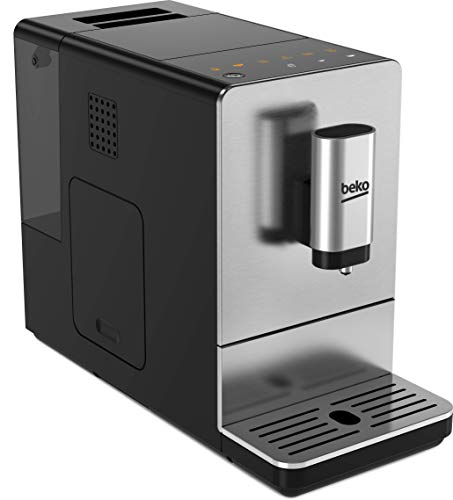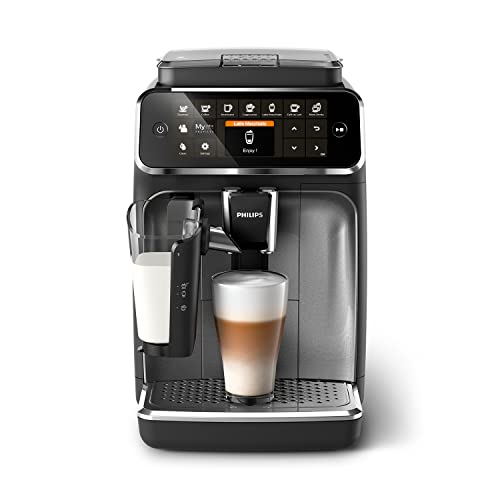Guide To Bean Coffee Machine: The Intermediate Guide On Bean Coffee Ma…
페이지 정보

본문
 Coffee Bean Coffee Machines
Coffee Bean Coffee MachinesIf you purchase a coffee bean machine you can take pleasure in fresh, delicious whole-bean cup coffee machines, roasted coffee that is prepared to your exact specifications. The machine grinds, measures, and tamps, and forces hot water into the grounds to create rich, delicious coffee.
These machines have many advantages such as ease of use and reduced environmental waste as compared to pod machines. The machine is fully automatic and can be operated with just a single button.
Grinding
When you make your own coffee, the kind of grind you select is crucial to get the best cup of joe. The size of the particle is important in addition to its shape and consistency. When beans are not properly ground, they can cause the water to flow too fast through the grind which can result in a lack of flavor or excessive extraction of bitterness.
A good grinder should have several sizes to allow you to select the most suitable method for your brew. It is essential to test different grind sizes, as they can greatly affect the flavor of your brew. The smallest particles are best for espresso and French presses, whereas larger, coarser ones are better for immersion brewing such as the Moka pot or Chemex.
If you want to get an even more gourmet cup of coffee, you can try roasting your own beans and grinding them right before making the coffee. This will increase the flavor and aroma of your brew, and will help you make a perfect cup every time. It is also important to keep the ground beans in an airtight container in a cool, dark place to preserve their freshness and flavor.
Commercial machines that use beans to cup provide unbeatable convenience. They let you enjoy barista quality coffee at the touch of a button. These machines handle everything from making the beans to tamping making them a great option for busy cafes and offices.
They begin by grinding the desired beans to a precise grind size. They can be configured to match your preferred brewing method and can be programmed to serve the desired amount of cups at a time. Certain machines will automatically compact the grounds to ensure the most efficient extraction.
A bean coffee machine to cup machine will usually have an enormous hopper to fill with whole beans. The machine will automatically grind the beans and dispensing the proper amount for the brew you choose. The machines usually display to display the size of the grind and the dose chosen and the total amount of drinks it's designed to prepare.
Extraction
When the coffee bean is ground it breaks down into smaller pieces called particles. The size of the particles could have an impact on the extraction process and the final cup's taste. In the machine that brews coffee the size of the particles is controlled so it matches the extraction method required by the machine. This lets you enjoy the best cup of coffee every time, and doesn't require the skill of baristas.
A bean-to-cup machine allows you to adjust the brewing time to achieve the exact strength you desire. This can be a significant advantage over pod machines, which typically offer less control and may result in weaker or more bitter tasting coffee. Bean-to-cup machines allow you to control not only the brew-time but also the water temperature. This allows you to decide how strong your coffee will be.
Extraction is an extremely delicate process that is dependent on the correct proportion of particle size, dose and tamping pressure. A poorly extracted coffee can be caused by any of these variables. Coffee that is not extracted properly will taste sharp and sour, while over-extracted coffee will taste dry and bitter.
To ensure that your coffee is extracted correctly, it's important to invest in a top quality grinder and the correct beans. Light roasts are often not the best choice for fully automated or espresso machines, as the short extraction process can result in a coffee that is dry and lacking in body. Darker roasts with a higher Robusta percentage, such as our Jhai (100% Robusta), or Tiga Terra are a better choice for these machines, because they have more robust flavors and bodies.
The final decision between a bean coffee maker-to cup machine and a pod coffee maker is a matter of your personal preference and the convenience. Pod coffee machines provide an easy way to make tea and coffee, but they're generally less efficient than a home bean to cup coffee machine-to-cup device and can create a lot of waste due to the disposal of the discarded pods.
Dispensing
By using whole beans, you can save money and enjoy more flexibility. However this also means your machine requires more regular maintenance and cleaning than a pod-based model.
These machines are designed to be low-maintenance, and have many features that make this task simpler. Most bean-to cup coffee makers have automatic rinsing cycles and cleaning cycles. This makes it simple to maintain your machine without disrupting your daily activities.
The ability to add hot, steaming milk for coffee beverages is an additional convenient function. This allows your team members to adjust their drink to suit their preferences and tastes, while increasing productivity. Additionally, it's a great way to show your team members that you care about their well-being. It has been proven scientifically that coffee can boost the production of dopamine as well as norepinephrine. This improves focus and motivation at work.
Some models also offer beverage customization options, such as the ability to texturize milk for cappuccinos as well as lattes. This feature is a key selling point for baristas who might only have a limited amount of time to prepare each coffee cup.
The size of the water tank and the bean hopper are crucial aspects to look out for when selecting a top-quality bean-to cup coffee maker. The water tank determines the length of time the machine will run before it needs to be filled up and the size of the hopper affects the frequency with which you'll have to replenish the beans. Generally, the larger the capacity of each, the less frequently you'll need to replenish.
Before you purchase a bean to cup coffee machine home-to-cup coffee maker, you should carefully consider the type of beans you'll be using since different grind sizes affect the taste and consistency of each cup. Additionally, you'll want to examine the machine's programmable settings that allow users to alter the flavor of their coffee to create their ideal beverage every time.
The spouts that dispense coffee on your coffee machine could get blocked by coffee residue or other particles left behind after grinding. To avoid an inconsistent and slow flow that could result in an insufficient amount of grounds for coffee, the spouts should be cleaned regularly. This can be caused by excessively coarse grinding settings or overly oily or dry beans, or a lack of regular cleaning and cleaning.
Cleaning
Cleaning coffee machines is an essential part of maintaining one. It stops the buildup and accumulation of residues, which could negatively affect the taste and quality. Regular cleaning ensures that the machine is in good condition and decreases the chance of a breakdown that could lead to costly repairs. Many bean-to-cup coffee machines come with a built-in cleaning cycle which will flush through pipes to clean the brewing unit. Some will have separate milk side cleaning cycle in order to ensure that both spouts are clean and safe.
A good rental provider will usually train their staff on the full maintenance and cleaning procedure during installation. This will help reduce confusion and ensure that the steps are correctly followed. Clear instructions and a thorough understanding of the procedure will help you avoid costly repairs or drinks of poor quality.
It is recommended to wash the carafe, the permanent filter and brew basket after every use with hot soapy water or in the dishwasher if they're certified safe for this. It is also a good idea to run three or more times of fresh water with no K cups or ground coffee in the machine between use. This will help remove any oily residue and will stop the growth of bacteria, mould or yeast.
For single-serve coffee machines or pods, it is a good idea to clean the machine thoroughly and descale every 4 weeks. A vinegar solution is normally used for this. Add up to four cups of vinegar to the reservoir and run the machine through a brewing process. When the cycle is finished clean and descale the machine according to the instructions of the manufacturer and run a couple of cycles of clean water to eliminate any vinegar smell.
 Commercial machines often come with a built-in telemetry system that records the details of every cleaning cycle. This can be viewed by you or your supplier to ensure that the machine is being cleaned regularly. This can also alert you to any moving parts that have become seized or stuck, which could need more precise repair and maintenance.
Commercial machines often come with a built-in telemetry system that records the details of every cleaning cycle. This can be viewed by you or your supplier to ensure that the machine is being cleaned regularly. This can also alert you to any moving parts that have become seized or stuck, which could need more precise repair and maintenance.- 이전글Why Nobody Cares About Pragmatic Casino 24.12.12
- 다음글Seven Simple Ways The Pros Use To Promote Learn More Plumbing Services Los Angeles 24.12.12
댓글목록
등록된 댓글이 없습니다.
